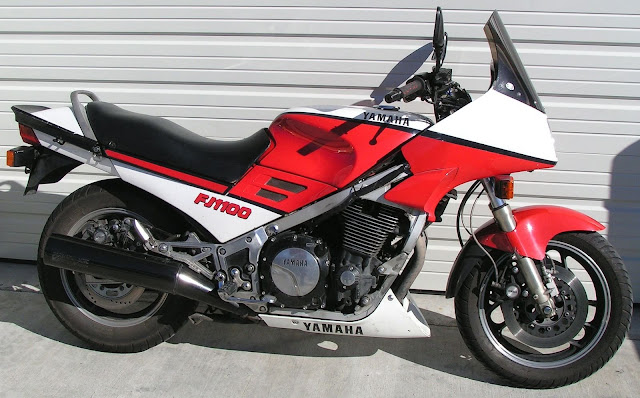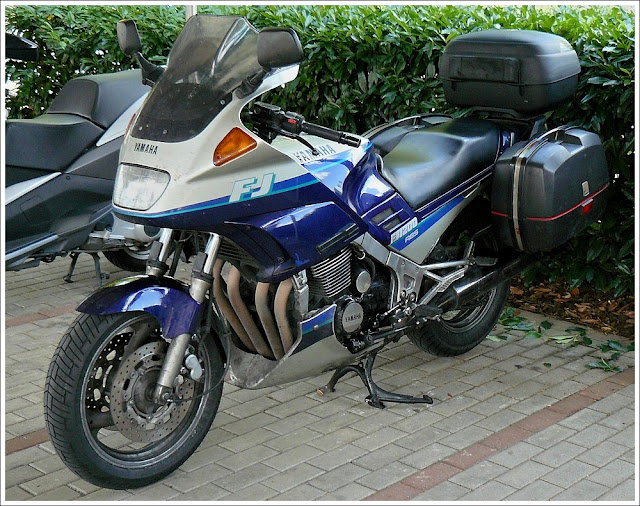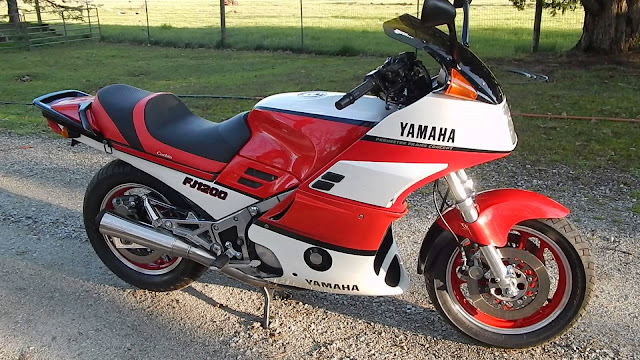Despite its origins as a sports hike, the FJ excelled in a sports-touring role and was often fitted with panniers.
The FJ’s distinctive look, with fairing cut away to reveal the big air-cooled four-cylinder engine beneath, changed very little in a decade of product inn.
Yamaha took a long time to build a big four-stroke that matched the popularity of the firm's smaller two-stroke models. Success finally came with the FJ1200 sports-tourer, which changed little during a decade in production. Yet ironically the Yamaha found its niche almost by accident, as its predecessor the FJ 1100, released two years earlier in 1984, had been created as an ‘out-and-out high performance sports machine', in Yamaha's words - only to be outgunned by Kawasaki's more aggressive GPZ900R.
The FJ 1100 itself was a fast and fine bike that finally proved the ability of Yamaha’s four-stroke engineers, and in any previous year would have taken the honours for pure performance. Instead, the sportier Kawasaki’s arrival meant that the FJ became known as a long-distance roadburncr - a role for which it was superbly well equipped due to its torquey engine, stable handling and comfort.
Sporting pretensions
That Yamaha was capable of producing a powerful and reliable four-cylinder engine came as no surprise, for the firm’s experience stretched back to the XS1100 of 1978. The FJ format incorporated a 16-valve cylinder head for the first time, although ironically the bike's sporting pretensions ensured that final drive was by chain instead of a more practical shaft. Yamaha moved fast to improve the original FJ, enlarging its I097cc air-cooled. 16- valve four-cylinder engine to 1188cc to produce the FJ 1200. At the same time some details were refined while the basic layout was retained.
If the FJ’s engine owed much to previous Yamahas, its chassis was much more innovative. The frame was a rectangular-section steel unit that appeared to have been influenced b\ Bimota. Main rails ran from the swingarm pivot area, around the cylinder head, then around the forks and 'teering head before joining at the front of the bike. Yamaha called the design ‘Lateral’ or ‘Perimeter* Frame Concept, depending on the market.
Even when the FJ1200 was released, its aircooled engine was described by one magazine tester as an anachronism. But neither that rider, nor many others, complained about the bikeY performance. The bigger motor had the same peak power output of 125bhp. and produced even more of the strong, seamless low-rev torque tor which the original FJ had become renowned.
Whether it had one person to cam or two. the Yamaha surged smoothly forward from walking pace in third gear. And once out of town, the rider's left boot was barely required as the FJ delivered scorching performance without leaving the tallest ratio of its five-speed gearbox. Given enough room the Yamaha was good for 150mph (241 km/h), but more important was its effortless feel and the smoothness with which it sat at high speed.
At 5761b (261kg) the FJ1200 was not the lightest of superbikes, but it handled well. Its frame was strong, its suspension well-damped if slightly soft for hard riding, and for such a big, roomy bike it was easy to manoeuvre. And the Yamaha was practical too. Its half-fairing and reasonably tall screen combined with features including a large fuel tank, thick dual-seat and roomy riding position to make for relaxed long-distance travel.
In 1988, two years after its introduction, the FJ 1200 was updated with a 17-inch front wheel, in place of the original 16-incher, plus revised suspension, brakes and screen. By this time the FJ had become the yardstick against which other sports-tourers were judged. It remained popular well into the following decade, gaining features including optional anti-lock brakes, but retaining its look and personality to the end.
Enlarging the FJ 1100’s engine to II88cc did not alter its I25hhp peak output, hut added to the low-rev and mid-range response for which the aircooled unit was famous. Had Yamaha’s designers known the FJ’s eventual role, they ought have chosen final drive by shaft.
Although the FJ was too heavy and softly sprung to compete with sportier superbikes on a racetrack, it matched most bikes on the road. Ground clearance was lacking at severe lean angles, but for most riders the Yamaha’s roomy riding position was adequate compensation.
Specification Yamaha FJ1200 (1986)
- Engine Air-cooled dohc 16-valve four
- Capacity 1188cc (77 x 63.8mm)
- Maximum power 125bhp @ 8500rpm
- Transmission Five-speed, chain final drive
- Frame Steel perimeter
- Suspension Telescopic front; monoshock rear
- Brakes Twin discs front; disc rear
- Weight 576lb (261kg)
- Top speed 150mph (241 km/h)





















0 comments: